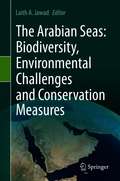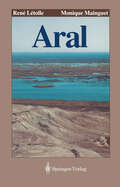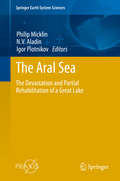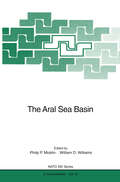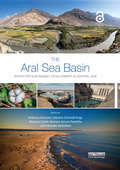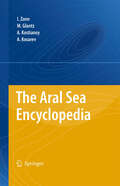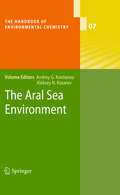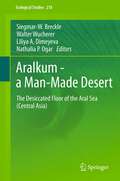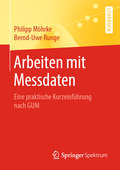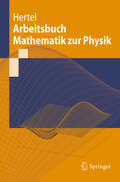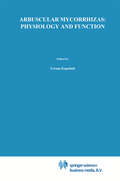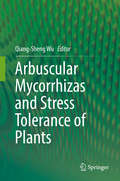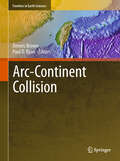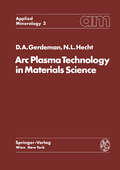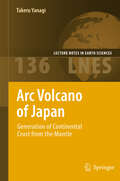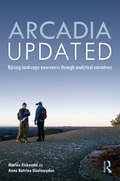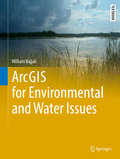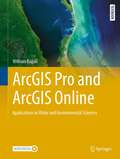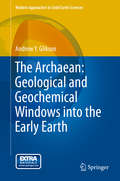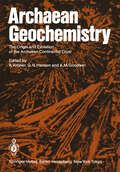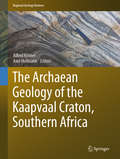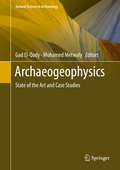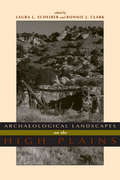- Table View
- List View
The Arabian Seas: Biodiversity, Environmental Challenges and Conservation Measures
by Laith A. JawadThe Arabian Seas Marine Region encompasses marine areas from Djibouti to Pakistan, including the northern part of Somalia, the Red Sea, the Arabian/Persian Gulf, and parts of the Arabian Sea. Human pressures on the coastal and marine environments are evident throughout the region, and have resulted in harmful environmental effects. Oil and domestic, urban and industrial pollutants in several areas of this part of the world have caused local habitat degradation, eutrophication and algal blooms. Further, coastal landfill, dredging, and sedimentation, as well as nutrient and sediment runoff from phosphate mining, agriculture and grazing, and reduction in freshwater seepage due to groundwater extraction are all contributing to the degradation of coastal environments. This book discusses aspects not covered in other books on the region, which largely focus on marine biodiversity, and examines several environmental challenges that are often ignored, but which have a significant impact on the environment. Evaluating the status quo, it also recommends conservation measures and examines the abiotic factors that play a major main role in the environmental changes. Lastly, the book addresses the biodiversity of the area, providing a general context for the conservation and management measures discussed.
The Aral Sea: The Devastation and Partial Rehabilitation of a Great Lake (Springer Earth System Sciences #10178)
by Philip Micklin N. V. Aladin Igor PlotnikovThe book is structured into six core parts. The first part sets the scene and explains how the use of Aral basin water resources, primarily used for irrigation, have destroyed the Aral Sea. The team explains how spheres and events interact and the related problems. Part 2 examines the social consequences of the ecological catastrophe and the affect of the Aral Sea desiccation on cultural and economic conditions of near Aral region. Part 3 explores the scientific causes of the destruction using detailed analyses and data plus some of their own research spanning aquatic biology, terrestrial biology, hydrology, water management and biodiversity. They also share some of the latest archaeological discoveries and paleobotanical analysis to delineate past levels and characteristics of the Aral Sea. There is particular focus on modern remote sensing and GIS techniques and how they can monitor the Aral Sea and the environment. Part 4 discusses regional and international initiatives to mitigate human and ecological problems of the Aral Sea and the wider political and economic consequences. With thorough insight of the total environment cost, the final chapters of the book will provide lessons for the future. There are insightful case studies throughout. Multidisciplinary by nature, all titles in our new reference book series will explore significant changes within the Earth’s ecosystems and to some extent, and will tackle ways to think about our changing environment.
The Aral Sea Basin (Nato Science Partnership Subseries: 2 #12)
by Philip P. Micklin and William D. WilliamsThe Aral Sea Basin, which is located in the central Asian part of the former Soviet Union, is undergoing dramatically rapid and intense environmental change. Pervasive human misuse and overuse of its water, land, and other critical natural resources have led to severe degradation of key ecological systems. This book analyses the environmental, human and economic problems that have arisen and presents recommendations for future research needs. Primary focus is on the drying of the Aral Sea, but related issues of diminished river flow, land and water pollution, and degradation, ecosystem deterioration, and adverse effects on humans are also examined.
The Aral Sea Basin: Water for Sustainable Development in Central Asia (Earthscan Series on Major River Basins of the World)
by Stefanos Xenarios Dietrich Schmidt-Vogt Manzoor Qadir Barbara Janusz-Pawletta Iskandar AbdullaevThis book offers the first multidisciplinary overview of water resources issues and management in the Aral Sea Basin, covering both the Amu Darya and Syr Darya River Basins. The two main rivers of Amu Darya and Syr Darya and their tributaries comprise the Aral Sea Basin area and are the lifeline for about 70 million inhabitants in Central Asia. Written by regional and international experts, this book critically examines the current state, trends and future of water resources management and development in this major part of the Central Asia region. It brings together insights on the history of water management in the region, surface and groundwater assessment, issues of transboundary water management and environmental degradation and restoration, and an overview of the importance of water for the key economic sectors and overall socio-economic development of Central Asian countries, as well as of hydro politics in the region. The book also focusses on the future of water sector development in the Basin, including a review of local and international actors, as well as an analysis of the current status and progress towards the Sustainable Development Goals by Basin countries. The book will be essential reading for those interested in sea basin management, environmental policy in Central Asia and water resource management more widely. It will also act as a reference source for decision-makers in state agencies, as well as a background source of information for NGOs. Chapter 8 of this book is freely available as a downloadable Open Access PDF under a Creative Commons Attribution-Non Commercial-No Derivatives 3.0 license. https://tandfbis.s3-us-west-2.amazonaws.com/rt-files/docs/Open+Access+Chapters/9781138348882_oachapter08.pdf
The Aral Sea Basin: Water for Sustainable Development in Central Asia (Earthscan Series on Major River Basins of the World)
by Stefanos Xenarios Dietrich Schmidt-Vogt Manzoor Qadir Barbara Janusz-Pawletta Iskandar AbdullaevThis book offers the first multidisciplinary overview of water resources issues and management in the Aral Sea Basin, covering both the Amu Darya and Syr Darya River Basins. The two main rivers of Amu Darya and Syr Darya and their tributaries comprise the Aral Sea Basin area and are the lifeline for about 70 million inhabitants in Central Asia. Written by regional and international experts, this book critically examines the current state, trends and future of water resources management and development in this major part of the Central Asia region. It brings together insights on the history of water management in the region, surface and groundwater assessment, issues of transboundary water management and environmental degradation and restoration, and an overview of the importance of water for the key economic sectors and overall socio-economic development of Central Asian countries, as well as of hydro politics in the region. The book also focusses on the future of water sector development in the Basin, including a review of local and international actors, as well as an analysis of the current status and progress towards the Sustainable Development Goals by Basin countries. The book will be essential reading for those interested in sea basin management, environmental policy in Central Asia and water resource management more widely. It will also act as a reference source for decision-makers in state agencies, as well as a background source of information for NGOs. Chapter 8 of this book is freely available as a downloadable Open Access PDF under a Creative Commons Attribution-Non Commercial-No Derivatives 3.0 license. https://tandfbis.s3-us-west-2.amazonaws.com/rt-files/docs/Open+Access+Chapters/9781138348882_oachapter08.pdf
The Aral Sea Encyclopedia (Encyclopedia of Seas)
by Igor S. Zonn M. Glantz Aleksey N. Kosarev Andrey G. KostianoyThe ‘‘Aral Sea Encyclopedia’’ is the first one in the new series of encyclopedias about the seas of the former Soviet Union. Preparing it we faced certain difficulties. The thing is that this encyclopedia is a monument to the sea that is disappearing during our lifetime. The world community considers the situation with the Aral Sea and all changes that occurred in its whereabouts in the recent decades as one of the most serious, if not disastrous anthropogenic environmental crises of the 20th century. Before 1960, this was a water-abundant sea-lake that was fourth among world lakes after the Caspian Sea (USSR, Iran), the Great Lakes (USA, Canada) and Victoria Lake (Africa). This was a real ‘‘pearl’’ among the sands of the largest deserts, the Karakums and the Kyzylkums. Navigation between the sea ports Muinak and Aralsk and fisheries famous for the Aral breams, barbells, sturgeons, shemaya, and others were developed here. One could find beautiful recreational zones and beaches here. The deltas of the Amudarya, the major river of Central Asia, and the Syrdarya bringing their waters into the Aral Sea were famous for their biodiversity, fishery, muskrat rearing, reed prod- tion. The local population found occupations related to the water infrastructure.
The Aral Sea Environment (The Handbook of Environmental Chemistry #7)
by Andrey G. Kostianoy Aleksey N. KosarevAs the environmental issues in the Aral Sea continue to worsen, this volume presents an up-to-date synthesis of those issues – from the paleohistory and archaeology of the region, to the physical, chemical and biological state of the sea today.
Aralkum - a Man-Made Desert: The Desiccated Floor of the Aral Sea (Central Asia) (Ecological Studies #218)
by Siegmar-W. Breckle, Walter Wucherer, Liliya A. Dimeyeva and Nathalia P. OgarHaving been the fourth largest lake on the globe roughly 50 years ago, today the Aral Sea no longer exists. Human activities caused its desiccation and the formation of a huge new desert, the Aralkum, which can be regarded as one of the greatest ecological catastrophes and - at the same time - the largest primary succession experiment of mankind. This volume brings together the results of international and interdisciplinary long-term studies on the new desert ecosystem and is divided into four main sections. The first section provides an overview of the physical characteristics of the area and covers geological, pedological, geomorphological and climatological aspects and their dynamics, especially dust-storm dynamics. The second focuses on the biotic aspects and highlights the spatial and temporal patterns of the flora and fauna. In the third section studies and projects aiming to combat desertification by phytomelioration and to develop strategies for the conservation of biodiversity are presented. The book is rounded off with a section providing a synthesis and conclusions.
Arbeiten mit Messdaten: Eine praktische Kurzeinführung nach GUM
by Philipp Möhrke Bernd-Uwe RungeDas vorliegende Lehrbuch bietet Studierenden der Natur- und Ingenieurswissenschaften einen übersichtlichen und anschaulichen Einstieg in den Umgang mit Messdaten und deren Interpretation unter Verwendung der Messunsicherheit – früher oft Fehlerrechnung genannt. Dabei stehen das Verständnis und die Vermittlung von direkt anwendbarem Wissen im Vordergrund. Auf lange mathematische Herleitungen wird weitgehend verzichtet.Auf Basis einiger einfacher Grundprinzipien wie der Verteilung der Messwerte oder dem mathematischen Modell einer Messung führt dieses Buch in zentrale Themen ein:- das Messen an sich,- die Angabe von Messergebnissen,- das Konzept der Unsicherheit,- die Auswertung von Messdaten mittels verschiedener Methoden,- sowie die Bewertung der erhaltenen Ergebnisse.Alle diese Themen werden anhand vielfältiger Beispiele ausführlich dargestellt und die Anwendung der abstrakten Konzepte anhand konkreter Zahlenbeispiele veranschaulicht. Fragen zur Selbstkontrolle sowie zur Vertiefung der Inhalte runden jedes Kapitel ab.
Arbeitsbuch Mathematik zur Physik (Springer-Lehrbuch)
by Peter HertelDas Arbeitsbuch zu den Lehrbüchern „Theoretische Physik“ und „Mathematikbuch für Physik“ enthält 256 Aufgaben mit ausführlichen Lösungen. Diese erste Aufgabensammlung speziell für Studierende der Physik kann unabhängig vom Lehrbuch genutzt werden. Die Aufgaben wurden mit Blick auf die wirklich notwendigen Kenntnisse ausgewählt, die Lösungen werden schrittweise ausgeführt und ermöglichen die direkte Umsetzung. Der Band ist für Haupt- und Nebenfachstudierende der Physik geeignet, die ihre Mathematik-Kenntnisse vertiefen wollen.
Arbuscular Mycorrhizas: Physiology and Function
by Yoram Kapulnik David D. Douds Jr.Recent years have brought an upsurge of interest in the study of arbuscular mycorrhizal (AM) fungi, partly due to the realization that the effective utilization of these symbiotic soil fungi is likely to be essential in sustainable agriculture. Impressive progress has been made during the last decade in the study of this symbiosis largely as a result of increasing exploitation of molecular tools. Although early emphasis was placed on the use of molecular tools to study physiological processes triggered by the symbiosis, such as expression of symbiosis-specific polypeptides and modulation of host defences, other applications await. It was obvious to us that gathering leaders in the field to summarize these topics and point out research needs was necessary if we were to understand the physiology and function of AM fungi at a molecular level. In addition, we have taken the opportunity to present these reviews in a logical sequence of topics ranging from the initiation of the life cycle of the fungus to its functions in plant growth and in the below ground ecosystem. It was a challenge to limit this flood of information to the confines of one text. This is a very exciting time for mycorrhiza biologists and it is our hope that some of this excitement is conveyed to our readers.
Arbuscular Mycorrhizas and Stress Tolerance of Plants
by Qiang-Sheng WuThis book reviews the potential mechanisms in arbuscular mycorrhizas (AMs), in the hope that this can help arbuscular mycorrhizal fungi (AMF) to be more used efficiently as a biostimulant to enhance stress tolerance in the host plants. AMF, as well as plants, are often exposed to all or many of the abiotic and biotic stresses, including extreme temperatures, pH, drought, water-logging, toxic metals and soil pathogens. Studies have indicated a quick response to these stresses involving several mechanisms, such as root morphological modification, reactive oxygen species change, osmotic adjustment, direct absorption of water by extraradical hyphae, up-regulated expression of relevant stressed genes, glomalin-related soil protein release, etc. The underlying complex, multi-dimensional strategy is involved in morphological, physiological, biochemical, and molecular processes. The AMF responses are often associated with homeostatic regulation of the internal and external environment, and are therefore critical for plant health, survival and restoration in native ecosystems and good soil structure.
Arc-Continent Collision (Frontiers in Earth Sciences)
by Dennis Brown Paul D. RyanArc-continent collision has been one of the important tectonic processes in the formation of mountain belts throughout geological time, and it continues to be so today along tectonically active plate boundaries such as those in the SW Pacific or the Caribbean. Arc-continent collision is thought to have been one of the most important process involved in the growth of the continental crust over geological time, and may also play an important role in its recycling back into the mantle via subduction. Understanding the geological processes that take place during arc-continent collision is therefore of importance for our understanding of how collisional orogens evolve and how the continental crust grows or is destroyed. Furthermore, zones of arc-continent collision are producers of much of the worlds primary economic wealth in the form of minerals, so understanding the processes that take place during these tectonic events is of importance in modeling how this mineral wealth is formed and preserved. This book brings together seventeen papers that are dedicated to the investigation of the tectonic processes that take place during arc-continent collision. It is divided into four sections that deal firstly with the main players involved in any arc-continent collision; the continental margin, the subduction zone, and finally the volcanic arc and its mineral deposits. The second section presents eight examples of arc-continent collisions that range from being currently active through to Palaeoproterozoic in age. The third section contains two papers, one that deals with the obduction of large-slab ophiolites and a second that presents a wide range of physical models of arc-continent collision. The fourth section brings everything that comes before together into a discussion of the processes of arc-continent collision.
Arc Plasma Technology in Materials Science (Applied Mineralogy Technische Mineralogie #3)
by Dennis A. Gerdeman Norman L. HechtAlthough a considerable amount of information concerning the applications for arc plasmas in the materials sciences is available, it is contained in literally thousands of separate manuals, technical notes, textbooks, and government and industrial reports. Each source generally deals with only one specific application or, at best, a narrow range of utilization. This book was developed to provide a comprehensive and up-to-date compilation of information in the technology of arc plasma utilization. The book is divided into two general categories: flame spraying and materials evaluation. In the flame spraying section a comprehensive review of the plasma spraying process is presented. The design and operation of plasma spraying equipment are described. Included are a description of the nature of a plasma, and the design and operation of plasma generators, powder feed systems and accessory control equip ment. The general process procedures, and associated process variables are de scribed. Particular emphasis is given to the particle heating process and the mechanisms for adherence and cohesion of coatings. Competitive flame spraying equipment is also detailed (combustion process, detonation and electric arc) and compared with the plasma spray process. A discussion and compilation of flame sprayed ceramic and metal materials, their properties and applications are also included.
Arc Volcano of Japan: Generation of Continental Crust from the Mantle (Lecture Notes in Earth Sciences #136)
by Takeru YanagiThis book presents an analysis of our current knowledge on the origin of the Earth’s continental crust. There are two aspects to consider: tectonic and igneous processes. Tectonic aspects include sedimentary accretion, terrane accretion, and continental collision at continental margins, in association with plate subduction. These processes result in the formation of large mountain belts, the building up of which literally grows the continents. However, these tectonic aspects are concerned with material recycling within the crust, and hence do not contribute to volumetric growth of continental crust. Igneous processes concern separation of continental crust from the mantle and result in the volumetric growth of continental crust. Therefore, the main focus of this book is to systematically examine why and how the Earth’s continental crust forms, by evaluating magmatic processes at island arcs where new continental crust forms.
Arcadia Updated: Raising landscape awareness through analytical narratives
by Marius Fiskevold Anne Katrine GeelmuydenArcadia Updated delves into the concept of landscape as it is shaped by the literary tradition and material works known as pastoral. Referring to several of the tradition’s works as well as scholarly critiques, Fiskevold and Geelmuyden highlight how individual landscape perception is primarily a cultural construct: each individual may see a unique landscape based on personal experiences, but simultaneously, landscape represents a tradition of engaging with nature and land, which has been largely forgotten. In re-engaging and connecting the practice of understanding landscapes with the pastoral tradition, the authors establish a common ground for treating landscape as an object of analysis in landscape planning. Arcadia Updated contributes to the methodological debate concerning landscape character assessment. Including 30 black-and-white images, this book analyses how humans engage with land organically, materially and communicatively. It seeks to raise landscape awareness as both an individual and a collective act of imagination. The practice of analysing landscapes is an ongoing culture of reinterpreting the land as landscape in response to society’s development and technical progress. The role of the landscape analyst is to interpret the contemporary world and offer visual explanations of it. This book will be beneficial to professional landscape planners as well as to academics and students of landscape, literature and cultural studies. It provides an essential contribution to the cross-disciplinarity of the landscape discourse.
Arcadia Updated: Raising landscape awareness through analytical narratives
by Marius Fiskevold Anne Katrine GeelmuydenArcadia Updated delves into the concept of landscape as it is shaped by the literary tradition and material works known as pastoral. Referring to several of the tradition’s works as well as scholarly critiques, Fiskevold and Geelmuyden highlight how individual landscape perception is primarily a cultural construct: each individual may see a unique landscape based on personal experiences, but simultaneously, landscape represents a tradition of engaging with nature and land, which has been largely forgotten. In re-engaging and connecting the practice of understanding landscapes with the pastoral tradition, the authors establish a common ground for treating landscape as an object of analysis in landscape planning. Arcadia Updated contributes to the methodological debate concerning landscape character assessment. Including 30 black-and-white images, this book analyses how humans engage with land organically, materially and communicatively. It seeks to raise landscape awareness as both an individual and a collective act of imagination. The practice of analysing landscapes is an ongoing culture of reinterpreting the land as landscape in response to society’s development and technical progress. The role of the landscape analyst is to interpret the contemporary world and offer visual explanations of it. This book will be beneficial to professional landscape planners as well as to academics and students of landscape, literature and cultural studies. It provides an essential contribution to the cross-disciplinarity of the landscape discourse.
ArcGIS for Environmental and Water Issues (Springer Textbooks in Earth Sciences, Geography and Environment)
by William BajjaliThis textbook is a step-by-step tutorial on the applications of Geographic Information Systems (GIS) in environmental and water resource issues. It provides information about GIS and its applications, specifically using the most advanced ESRI GIS technology and its extensions. Eighteen chapters cover GIS applications in the field of earth sciences and water resources in detail from the ground up. Author William Bajjali explains what a GIS is and what it is used for, the basics of map classification, data acquisition, coordinate systems and projections, vectorization, geodatabase and relational database, data editing, geoprocessing, suitability modeling, working with raster, watershed delineation, mathematical and statistical interpolation, and more advanced techniques, tools and extensions such as ArcScan, Topology, Geocoding, Hydrology, Geostatistical Analyst, Spatial Analyst, Network Analyst, 3-D Analyst. ArcPad, ESRI’s cutting-edge mobile GIS software, is covered in detail as well. Each chapter contains concrete case studies and exercises – many from the author’s own work in the United States and Middle East. This volume is targeted toward advanced undergraduates, but could also be useful for professionals and for anyone who utilizes GIS or practices spatial analysis in relation to geology, hydrology, ecology, and environmental sciences.
ArcGIS Pro and ArcGIS Online: Applications in Water and Environmental Sciences (Springer Textbooks in Earth Sciences, Geography and Environment)
by William BajjaliThis textbook serves as a practical guide for undergraduate and graduate students in geology, hydrology, ecology, and environmental sciences, teaching them applied GIS techniques. Presented as a step-by-step tutorial across seventeen chapters, the book starts with the fundamentals of GIS and progresses to real-life examples from geology and water resources. The focus is on ESRI's ArcGIS Pro, covering various tools for spatial, geostatistical, network, and 3-D analysis. Additionally, it explores ArcGIS Online and working with web apps like Web Map, StoryMaps, and GEO App.GIS applications, especially in water and environmental problem-solving, are rapidly growing worldwide. The demand for GIS experts utilizing spatial analysis in environmental science remains high. This textbook equips users with the necessary knowledge to become effective mappers and spatial analysts in the fields of environment, geosciences, and water resources, employing the latest state-of-the-art methodology.Each chapter provides exercises and supplementary materials available for download on SpringerLink, along with additional links for further learning opportunities.
The Archaean: Geological And Geochemical Windows Into The Early Earth (Modern Approaches in Solid Earth Sciences #9)
by Andrew Y. GliksonArchaean terrains contain a wealth of structural, stratigraphic, textural, mineralogical, geochemical and isotopic features allowing insights into the nature of the early Earth. This book is based on studies during 1964-2007 of Archaean terrains in Australia and to a lesser extent in South Africa and India, as well as on visits to Archaean terrains in Canada, the US and China, as well as petrological and geochemical studies of igneous and sedimentary rock suites from a range of terrains. The book will include a range of photographic and microscopic images, geological sketch maps and diagrams illustrating the lessons derived from field and the laboratory. Also other Archaean terrains are being reviewed.The book is intended for Earth scientists as well as broader intelligent readership.
Archaean Geochemistry: The Origin and Evolution of the Archaean Continental Crust
by A. Kröner, G. N. Hanson and A. M. GoodwinArchaean Geochemistry 1972 - 1984 The realisation that the continental crust contains well-preserved relics which date as far back as 4/5 of the Earth's age has given a great impetus to the study of early Precambrian terrains. As late as the mid-sixties the Archaean still constituted the 'terra-in cognita' of earth science. High metamorphic grades, poor out crop, and not least a widely assumed obliteration of early crustal records by convective recycling and thermal reworking had com bined to discourage research in this field. Many excellent local studies existed, notably around gold mining centres, but remained unrelated to a broader regional and theoretical understanding. This situation has changed as the consequence of two inter-related factors: (1) advances in isotopic methods and their application to Precambrian rocks, and (2) the recognition that some of the oldest terrains have retained a wealth of primary igneous and sedi mentary textures and even geochemical characteristics.
The Archaean Geology of the Kaapvaal Craton, Southern Africa (Regional Geology Reviews)
by Alfred Kröner Axel HofmannThis book provides a comprehensive overview of the evolution of one of the oldest and best-exposed Archaean cratons on this planet. There is currently a renewed interest in the early Earth, and the Kaapvaal craton has long served as a model for early crustal evolution. This unique multidisciplinary resource features information on geology, tectonics, geochemistry, and geochronology. It offers a wealth of new data on various aspects of the craton as well as contributions on the various crustal units by international specialists.
Archaeogeophysics: State of the Art and Case Studies (Natural Science in Archaeology)
by Gad El-Qady Mohamed MetwalyThis book describes the application of non-destructive geophysical methods in subsurface archaeological features. Such non-destructive methods are magnetometry, electrical resistance, electromagnetic conductivity, magnetic susceptibility and ground penetrating radar. This book also includes the last improvements in instrumentation, data processing, and interpretations of the collected data sets leading to the rapid progress in geophysical applications in the field of archaeological investigations. The book also provides complete case-studies and archaeological interpretation obtained our results carried out in different localities around the world.
Archaeological Landscapes on the High Plains
by Bonnie J. Clark Laura L. ScheiberArchaeological Landscapes on the High Plains combines history, anthropology, archaeology, and geography to take a closer look at the relationships between land and people in this unique North American region. Focusing on long-term change, this book considers ethnographic literature, archaeological evidence, and environmental data spanning thousands of years of human presence to understand human perception and construction of landscape. The contributors offer cohesive and synthetic studies emphasizing hunter-gatherers and subsistence farmers. Using landscape as both reality and metaphor, Archaeological Landscapes on the High Plains explores the different and changing ways that people interacted with place in this transitional zone between the Rocky Mountains and the eastern prairies. The contemporary archaeologists working in this small area have chosen diverse approaches to understand the past and its relationship to the present. Through these ten case studies, this variety is highlighted but leads to a common theme - that the High Plains contains important locales to which people, over generations or millennia, return. Providing both data and theory on a region that has not previously received much attention from archaeologists, especially compared with other regions in North America, this volume is a welcome addition to the literature. Contributors: o Paul Burnett o Oskar Burger o Minette C. Church o Philip Duke o Kevin Gilmore o Eileen Johnson o Mark D. Mitchell o Michael R. Peterson o Lawrence Todd
